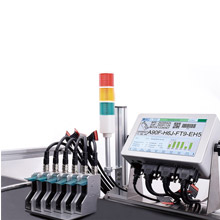As an Inkjet Label Printer Manufacturer, share with you. Thermal inkjet technology uses a thin film resistor to heat less than 0.5% of the ink in the ink ejection area to form a bubble. This bubble expands at a very fast speed (less than 10 microseconds), forcing ink droplets to eject from the nozzle. The bubble continues to grow for a few microseconds, then disappears back to the resistor. When the bubble disappears, the ink in the nozzle retracts. Then the surface tension will generate suction, pulling new ink to replenish the ink ejection area. Thermal inkjet technology is structured by such an integrated cycle technology program. In the piezoelectric inkjet technology, the ink is ejected from a nozzle similar to the thermal inkjet technology, but the formation method is formed by reducing the area where the ink is ejected. The size of the ejection area is controlled by applying voltage to one or more piezoelectric plates in the ejection area.
Thermal Inkjet Printer
Because the ink is prone to chemical changes at high temperatures, the directionality and volume of ink particles are not easy to grasp, and the edges of printed lines are easy to be uneven, which affects the print quality to a certain extent, which is its shortcomings. The micro-piezo print head technology uses the discharge characteristics of the crystal under pressure to stably eject ink at room temperature. It has the characteristics of strong control of ink droplets, easy to achieve high-precision print quality of 1440dpi, and the micro-piezoelectric inkjet does not require heating, and the ink will not undergo chemical changes due to heat, so the requirements for ink are greatly reduced. Liquid inkjet printers represent the mainstream products in the market.
When an inkjet printer prints an image, a series of complicated procedures are required. When the printer nozzle quickly sweeps the printing paper, the countless nozzles on it will eject countless small ink droplets to form the pixels in the image. Generally, there are 48 or more independent nozzles on the printer head to eject various colors of ink.
Generally speaking, the more nozzles, the faster the printing speed. Ink drops of different colors fall on the same spot to form different complex colors. It can be observed with a microscope that the place where the yellow and blue-violet inks are ejected at the same time is green, so we can think that the basic color of the print is formed in the inkjet overlay. By observing the simple four-color inkjet working method , We can easily understand the working principle of the printer: each pixel has 0 to 4 ink droplets covering it.
Our company also has Thermal Inkjet Printer on sale, welcome to contact us.

评论
发表评论